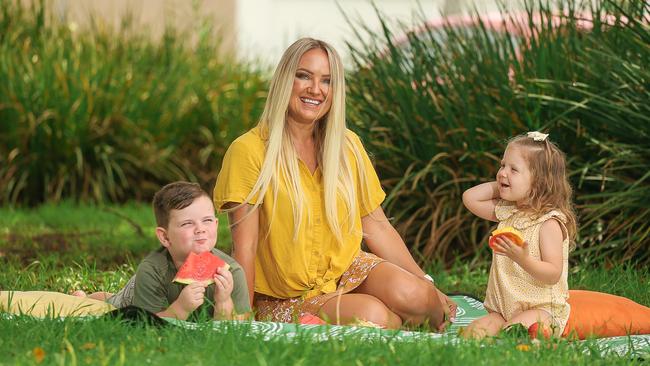Health of the Nation: The best foods for babies and what to avoid
Eight in ten babies and toddlers are not eating enough vegetables. See the foods to embrace – and what you need to cut out.
Pre + Post baby
Don't miss out on the headlines from Pre + Post baby. Followed categories will be added to My News.
Eight in ten babies and toddlers are not eating enough vegetables and by the time they start preschool this rises to 98 per cent.
What you feed you baby and toddler in the first 1,000 days of life will set up their taste preferences for life so it is important to steer them towards healthy real foods.
Busy working families often find it easier to opt for “healthy” packaged foods because of their convenience.
But studies have found 67 per cent of packaged baby foods failed to meet nutrition recommendations set by the World Health Organisation.
Even savoury foods like packets of pureed broccoli can be full of sugar in the form of fruit juice or puree.
WHAT TO FEED YOUR BABY
Ideally babies should be exclusively breastfed for six months.
Breastfed babies have a lower risk of diarrhoea and vomiting, eczema and asthma, middle ear infections, some childhood cancers and Type 2 diabetes and obesity later in life.

Breastfeeding is cheap and helps mothers reduce their weight after the birth and cuts their risk of ovarian cancer and pre-menopausal breast cancer.
Around six months, but not before 4 months:
Feed small amounts (a half a teaspoon to start) of pureed fresh foods like meat, poultry and fish (with no bones) and eggs, cooked vegies like potato, sweet potato, pumpkin and carrot, and fruit.
The latest advice from allergy experts is to introduce allergens such as peanut butter and eggs in the first year.
“Start to introduce all the flavours and textures so that that child grows up loving a wide variety of foods from the five food groups,” said Dr Robyn Littlewood and Fiona Nave, who are paediatric dietitians from Health and Wellbeing Queensland.
Around 8 months:
Introduce pureed cereals, fruit and full cream dairy products like natural yoghurt mixed with fresh fruit
The Australasian Society of clinical immunology and allergy says to help prevent allergies all infants should be given allergenic solid foods including peanut butter, cooked egg, dairy and wheat products in the first year of life. This includes infants at high risk of allergy.
Babies aged under 12 months should completely avoid foods with high levels of saturated fat, added sugars, and added salt and they should be restricted for toddlers aged 1-3 years.
Feeding children these types of foods can set them up to crave sweet, salty and fatty food for the rest of their lives.
After 12 months:
Three small main meals and one or two small snacks each day.
Transition them to eating family foods.
“Ninety five per cent of kids don’t eat enough vegies and when you take out potatoes, it’s even worse, much, much worse.” Dr Littlewood said.
Parents have to model eating healthy food and talk about it in a positive way, she said.
“Don’t say you are eating carrots because you are on a diet because that makes it seem like it’s a punishment. Instead say: ‘I love the crunchy carrots or these carrots make me feel good’,” she said.
AVOID PACKAGED FOOD
A recent study from Food For Health Alliance revealed 67 per cent of packaged baby foods failed to meet nutrition recommendations set by the World Health Organisation and were full of sugar in the form of fruit juice or puree.
“Even savoury foods like broccoli and spinach actually have quite a lot of fruit and sweeteners in them,” said Jane Martin executive manager of the Food for Health Alliance.

Western Sydney University’s Dr Catharine Fleming said recent research found only two out of 276 baby squeeze pouch products were nutritionally adequate and many contained more than the recommended serving size in a single pack.
“Adding sugar does big things to the biome (gut bacteria), it impairs cognition in and of itself. So you don’t need the unhealthy diet to have an effect of sugar. Sugar alone does something to cognition,” Professor Morris said.
“A cucumber stick, a crust of wholemeal bread or a banana are ways for children and toddlers to be able to feed themselves without having to have packaged foods,” Ms Martin added.
WHAT TO FEED YOUR TODDLER
A recent study from the Food For Health Alliance revealed 67 per cent of packaged baby foods failed to meet nutrition recommendations set by the World Health Organisation.
And, not surprisingly, excessive sugar was the main culprit.
“A cucumber stick, a crust of wholemeal bread or a banana are ways for children and toddlers to be able to feed themselves without having to have packaged foods,” the Alliance’s executive manager, Jane Martin, said.
From ages 2-3, each day toddlers should be eating:
2.5 serves of vegetables (such as ½ cup cooked green or orange vegies, 1 cup green leafy or raw salad vegies, ½ medium potato)
1 piece of fruit
4 serves of cereal (one serve is 1 slice wholegrain bread or ½ cup of brown rice)
1 serve of lean meats and poultry (80g cooked), fish (100g cooked), eggs (2 large), tofu (170g), nuts and seeds (30g), and legumes/beans (1 cup)
1.5 serves of dairy (such as 1 cup fresh UHT long life reconstituted powdered milk or 40g hard cheese, ¾ cup yoghurt)
4.5g of oil or fat.
For more examples of food and serving sizes for toddlers, visit www.eatforhealth.gov.au
HOW I GET MY KIDS TO EAT VEGETABLES
Mother-of-two Jacinta Rogers understands the importance of serving up healthy options and the right portion sizes for her children and is teaching them about it as they grow.
As a favourite pastime, the family explores local markets together, helping to spark curiosity in Reine, 5, and Myah, 2, around different types of foods on offer.
“Involving them in the selection process encourages them to think about their preferences and teaches valuable life skills, like understanding what’s in season and meal planning,” Ms Rogers said.
“When it comes to food, we prioritise fresh whole foods while maintaining a fun positive balance,” she said.

Myah, dubbed the “healthiest eater” in the family, naturally gravitates towards nutritional foods with broccoli, carrots, avocados and tomatoes among her favourites.
“When asked what she would like for dinner the answer is usually lamb chops,” Ms Rogers laughs.
The doting mother said her two-year-old’s willingness to try new foods has encouraged her older brother, Reine, to be open to “diverse flavours” after going through a fussy patch.
“Surprisingly to us all, Reine has a few new favourites, including seaweed which he used to screw his nose up at,” she said.
But when it comes to portion sizes, Ms Rogers said: “My kids’ appetites and moods change daily, so I encourage them to pay attention to their hunger cues and let me know when they have had enough.”
She said experimenting is crucial and a good trick to make food fun is creating shapes or animals from less-favourable foods.
“I wouldn’t want them to miss out on all the delicious food options we are lucky enough to have available and my dream is to keep them adventurous in life.”
- with Emma Cam



